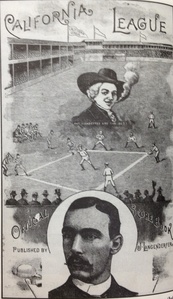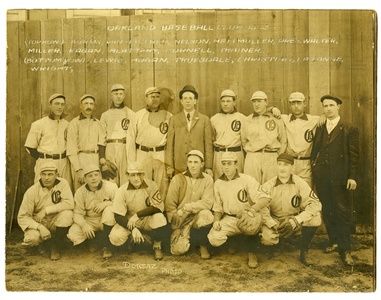 circa 1888: George Van Haltren and Fred Lange 3
circa 1888: George Van Haltren and Fred Lange 3
George Edward Martin Van Haltren (aka George Van Haltren) (March 30, 1866 – September 29, 1945) played for the Greenhood and Morans baseball team and later the Major Leagues. He was a left-handed pitcher who could also hit. He played in the Major Leagues for 17 years and put together a sterling career as both a pitcher and a hitter. Later he came back to Oakland and served as a manager-player the Oakland Oaks for 5 years, starting in 1905 at age 39. 1 After that, he was a manager and umpire for the Pacific Coast League.
It is possible that he was tricked into signing his first pro contract: at 20 years old W.A. Nimick of the Detroit team may have liquored him up before getting him to sign for the Pittsburgh minor league team. After Van Haltren thought about it, he decided to stay in Oakland with the G&Ms, then went pro. 2
Van Haltren was born March 30, 1865 in St. Louis to Peter Van Haltren and Alice Sheehan (Van Haltren). In 1868, the Van Haltrens moved to Oakland. His baseball career began in 1885 as a catcher for the Emeralds, then he quickly moved to the Greenhood and Morans. By 1889, he was playing left field full-time.
On March 27, 1889, Van Haltren married Blanche O’Brien of Oakland, and they had two daughters, ;Mary Elizabeth Van Haltren (1890 –?) and Dorothy Van Haltren (1895 – ?). 5
Copy/Paste ... Needs to be rewritten
George Van Haltren was the first great baseball star to come out of the Bay Area. He moved from St. Louis to Oakland with his family at the age of eight, and began his baseball career in the 1880's as the pitcher and leading hitter for the "Greenhood & Morans," a team sponsored by Jacob Greenhood and James T. Moran, owners of an Oakland clothing store. He continued to play for the Oakland team for several years after it was acquired by promoter Colonel Tom Robinson.
He acquired the nickname "Rip" from Rip Van Winkle, maybe because of his last name and maybe because of his flowing mustache, which he kept throughout his career.
He made his National League debut at the age of 21 on June 27, 1887 with Chicago. In his first outing, the highly touted California hurler tied the all-time undesired record by walking 16 batters while losing to Boston 17-11. Chicago manager Cap Anson immediately began to use the swift youngster in the outfield.
Van Haltren threw a six-inning no-hitter against Pittsburgh on June 21, 1888 (he also pitched a hitless seventh inning, but since the Colts could not complete their half before the rain, the official score reverted to six innings). But he didn't pitch at all in 1889, and hit .300 for the first of 12 seasons. He jumped to the Players' League in 1890 and went 15-10 for Brooklyn, while batting .335. He played for and briefly managed two Baltimore clubs, and on July 27, 1892, after collecting four straight hits the day before, Van Haltren went 5-for-5 against St. Louis.
In 1894 he joined the New York Giants. For a time, he roomed with pitcher Christy Mathewson. He became a star attraction himself at the Polo Grounds for a team that had fallen considerably since winning championships in 1888 and 1889. He was a center fielder and left handed lead off hitter who played with the kind of elan New Yorkers appreciated. His graceful, far-ranging, strong-armed outfield play set a high standard. In a contest sponsored by the New York Mirror in 1894, fans voted Van Halten the most popular player in New York and Brooklyn. The prize a silver bat. In 1896 he batted a career-high .351 and tied for the NL lead with 21 triples. His 45 stolen bases in 1900 tied him for the league lead; he had 583 steals lifetime. Between 1897 and 1901 he played in 454 straight games.
Until his major league career was curtailed by a broken ankle sustained while sliding into secondbase in May of 1902, Van Haltren played in a total of 1,984 games, with a career batting average of .316. As a pitcher, he struck out a total of 281 batters, and had a career ERA of 4.05.
In 1904 manager McGraw let Van Haltren go to Seattle in the Pacific Coast League. He hit .269 and set a permanent PCL record by coming to bat 941 times that season.
In 1905, Van Haltren came back home to Oakland to replace Pete Lohman as the Oaks' (then known as the Oakland "Commuters") second manager . Despite his age, as well as managing the team Van Haltren played center field, leading in total chances each year. He generally batted in the lead off position and was near the top in fielding percentage. Even as a playing manager, he always put the team first, however, not hesitating to bench himself in favor of a pinch hitter when necessary.
The 1905 season lasted eight long months, reaching an all time low on November 8, 1905, when the Oaks drew a paid attendance of 1 (that's right, one fan), due poor weather, the fact that a game was being played in San Francisco at the same time, and loss of fan interest because Oakland was out of contention.
Van Haltren kept the job through four more discouraging seasons, until June 6, 1909, when between games of a double-header against Sacramento, he was replaced as manager by pitcher Bill Reidy. Nine days later, he returned to the PCL as an umpire. He went on to umpire in the Northwestern League in 1912 and later to scout for Pittsburgh.
 George Van Haltren on the cover of an 1891 cover of the Oakland Baseball Club 3
George Van Haltren on the cover of an 1891 cover of the Oakland Baseball Club 3 Oakland Baseball Club, 1908. Van Haltren is 2nd from left, back row. Photo from California Historical Society 6
Oakland Baseball Club, 1908. Van Haltren is 2nd from left, back row. Photo from California Historical Society 6
Death and Burial
Van Haltren died September 29, 1945 at age 79 in his home on Merrimac Street near Telegraph Avenue. His funeral was at St. Francis de Sales, and he was buried in St. Mary's Cemetery. 4 There is no marker on his grave.
Links and References
- Nuggets on the Diamond: Professional Baseball in the Bay Area from the Gold Rush to the Present by Dick Dobbins and Jon Twichell, San Francisco: Woodford Press, 1994.
- Always on Sunday: The California Baseball League 1886-1915 by John E. Spalding, Kansas: Ag Press, 1992.
- George Van Haltren Oakland Oaks
- Home Field Advantage by Paul Brekke-Meisner
- George Van Haltren on Society for American Baseball Research
- Oakland Baseball Club, 1908 California Historical Society
- George Van Haltren on FindAGrave.com



